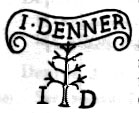Alto/Treble recorder* in f’ after Denner,
a = 415, boxwood with double or single holes, Baroque (English) fingering,
other woods (grenadilla, ebony) and carvings on demand.
Sound: brilliant and strong with easy and quick responds.
*you can hear it on the CD label “Classico” (CR 970501) with the ensemble “La Gioia, Berlin” (Frauke Rauterberg, recorder, Adrian Rovatkay baroque-bassoon et al.)

Jacob Denner, Nürnberg (1681 – 1735),
mark: I.Denner (in scroll with rolled up ends)/ fir-tree with the letters
‘I D’ on the right and left side of the shaft.
Eldest son of Johann Christoph Denner. Today both are considered the most famous German makers of the 18th c. and even in their lifetime had international reputation. He was employed at several courts as ‘Stadtmusicus’ (city musician) oboist (e.g. Bayreuth and Ansbach). We can presume, that his instruments found their way to Leipzig in the time that Bach worked there. (His father Johann Christoph was born at Leipzig).
Lit.: Herbert Heyde „Historische Musikinstrumente
im Bachhaus Eisenach, Eisenach 1976.
Guido Klemisch, „Blockflöte“ in “Bachs
Orkestermusik“ von Rampe/Sackmann, Kassel 2000, ISBN
3-6718-1345-7
Guido Klemisch, „Zur Bauweise der Blockflöte um 1700 und
Möglichkeiten des Nachbaus,“ in SAIM, Beiheft 12, Michaelstein/Blankenburg,
1992, S. 47
Ekkehart Nikkel, „Der Holzblasinstrumentenbau in der Freien
Reichsstadt Nürnberg“, München 1971, ISBN 3-87397-008-2
William Waterhouse, „The New Langwill Index“ London,
1993, ISBN 0-946113-04-1
Pillip T. Young , 4900 Historical Woodwind Instruments, London
1993, William Waterhouse,